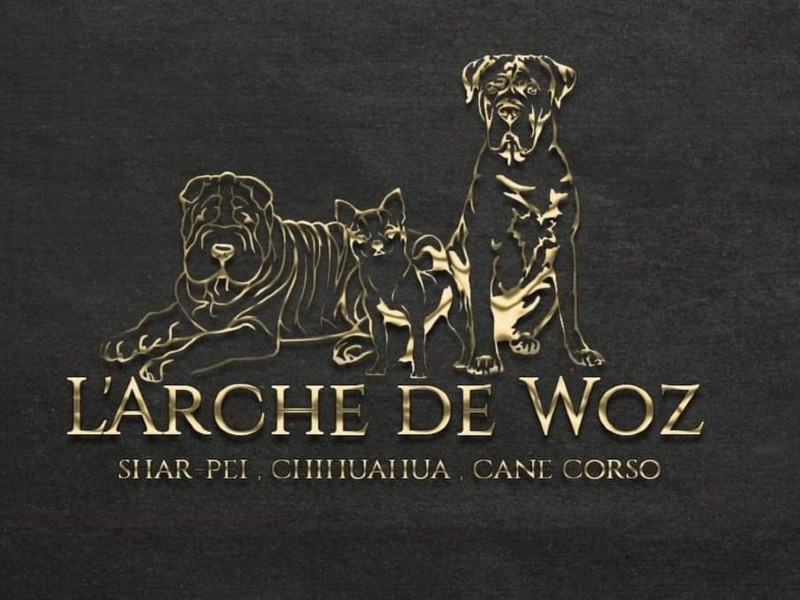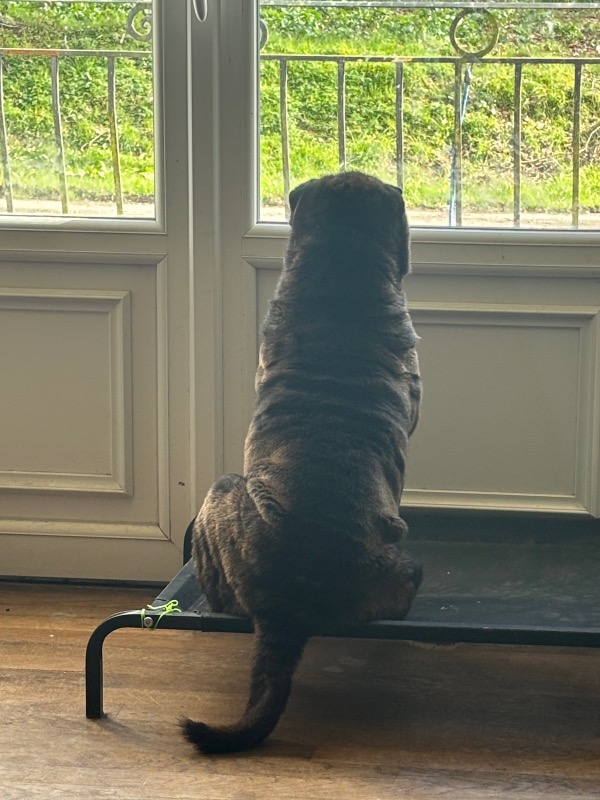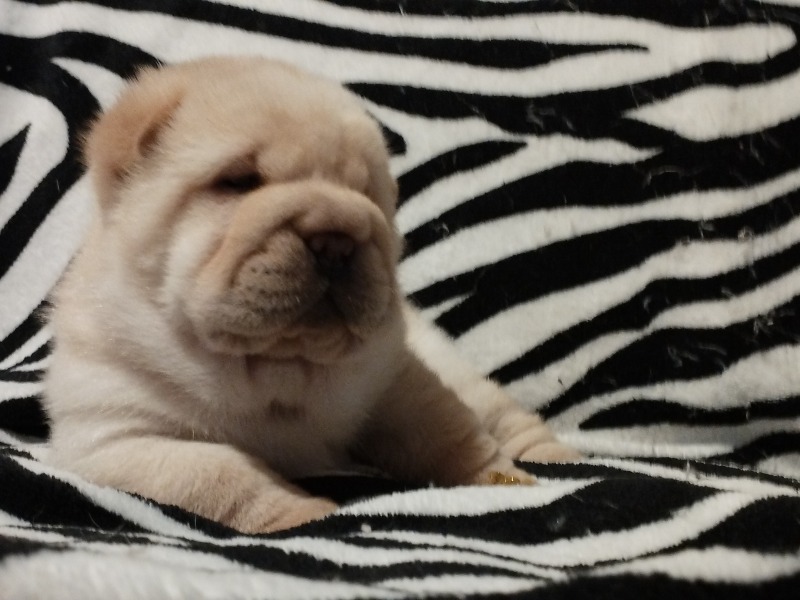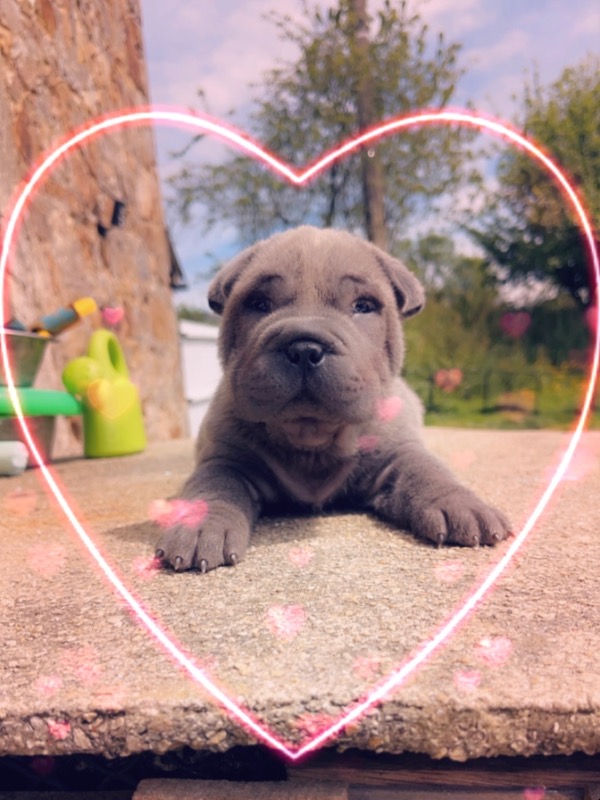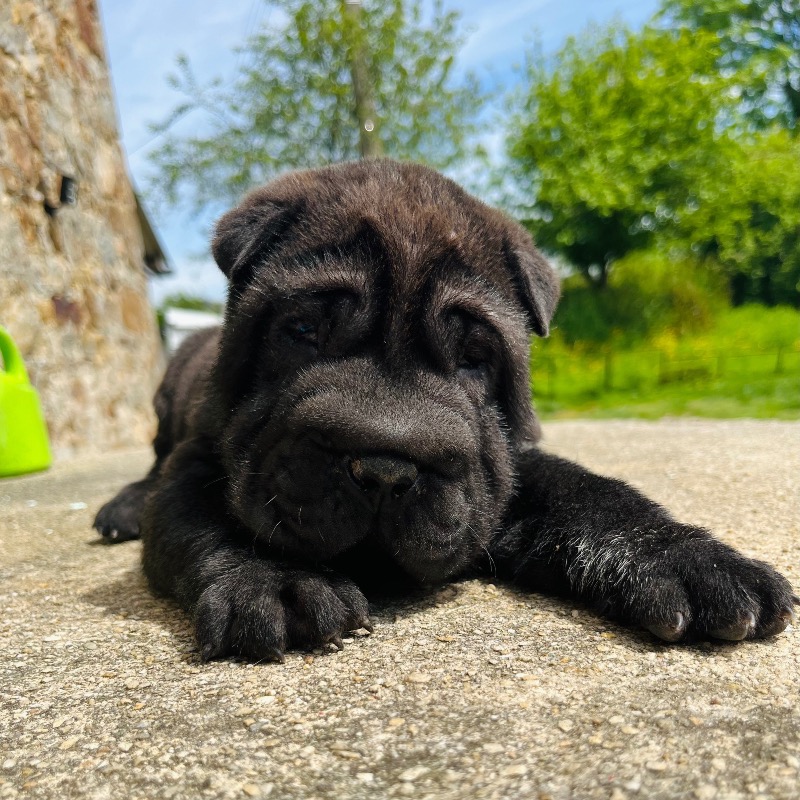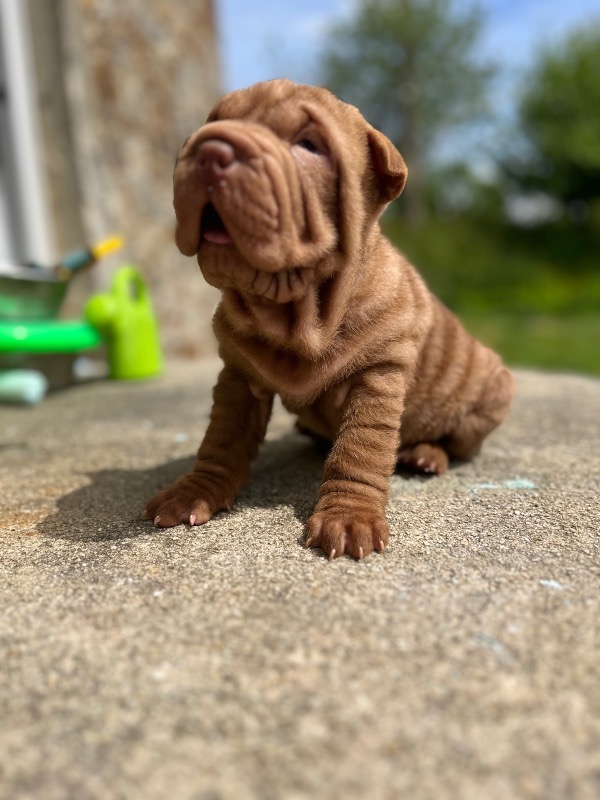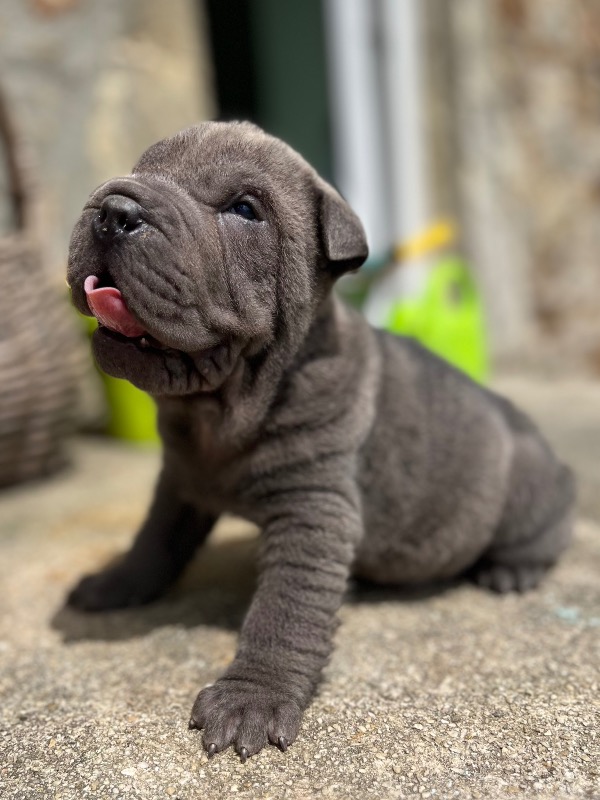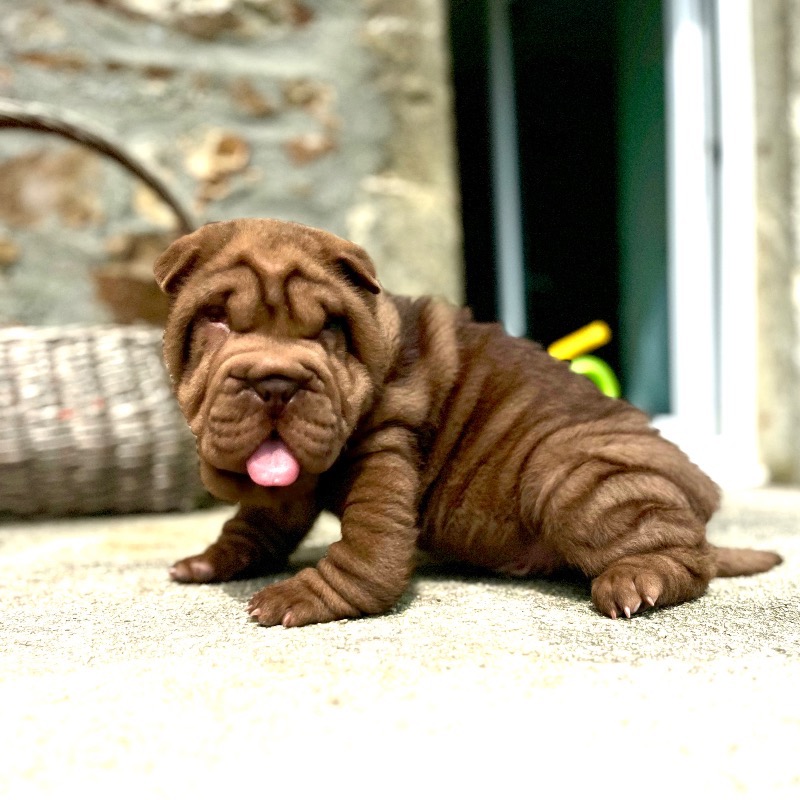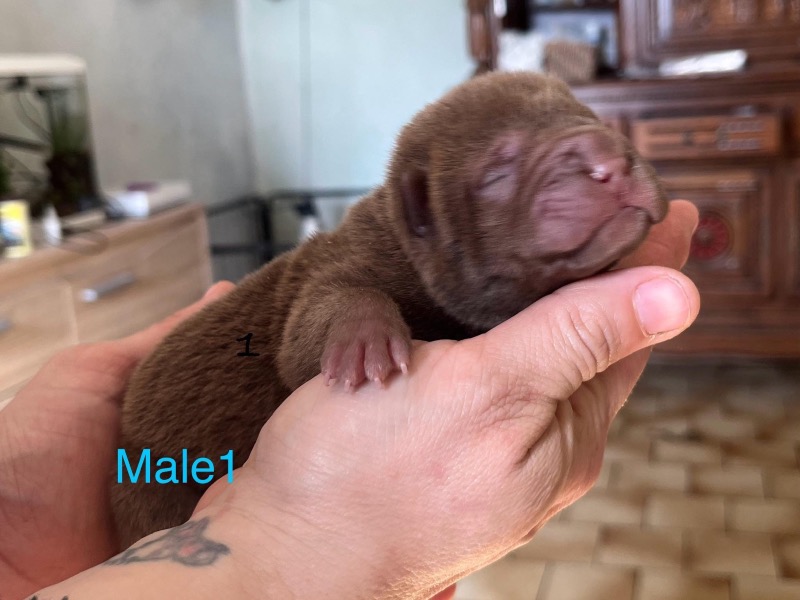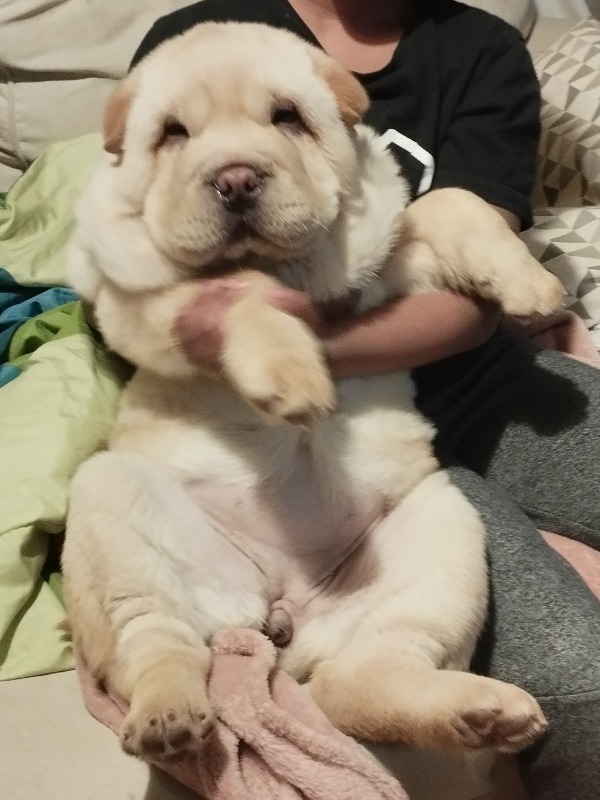Shar-pei
Welcome to our page dedicated to the breed of dog shar-pei!
Here, you will find all the useful information about shar-pei. This descriptive profile will allow you to discover the aspects of this breed. You can notably consult information about the average price, monthly and annual upkeep expenses, their health, name ideas, as well as their official recognition by competent authorities.
Explore this page to discover everything you need to know.
Overall description of the breed
The Shar-Pei was developed in China, specifically in the coastal regions of the southern part of the country. Its enigmatic name translates to "wrinkled skin" in Chinese. This breed has a history of over 2000 years, dating back to the era of archaeological discoveries where bronze statuettes depicted it. Initially appreciated by Chinese peasants for its hunting and guarding abilities, the Shar-Pei was later trained and selected to become a fighting dog.
Though naturally not aggressive, stories suggest that before battles, these dogs were heavily intoxicated and starved to increase their aggressiveness. This practice was eventually abandoned years later due to the introduction of more aggressive and combative breeds in China, which gradually replaced the Shar-Pei.
The cessation of this activity led to a disinterest in the breed, resulting in a significant decline in birth rates and nearly endangering the future of this loyal companion. Fortunately, the Shar-Pei was saved from extinction through the dedication of passionate breeders. Among them, the most active and recognized were Mr. Law and Mr. Chung. Both undertook the task of collecting dozens of subjects scattered throughout China in their respective kennels. They also sought the help of American breeders, who had significantly contributed to the breed's development in a large part of the country.
These imports injected fresh blood into the Chinese lines and established a rigorous selection program. Thanks to their efforts, the breed was revitalized and definitively preserved a few years later. The International Cynological Federation officially registered the breed on June 30, 1981, and the current official standard was updated on April 14, 1999.
The Shar-Pei falls into the category of medium-sized dogs, with a broad and sturdy body. Its chest is also wide and deep. One of its main characteristics is its thick, wrinkled skin that covers its body from its back to its muzzle, including the lower limbs. Its neck and head are massive, with the head appearing large in relation to the rest of the body but remaining proportional overall.
Its particularly broad muzzle has a square shape, reminiscent of a hippopotamus, and its stop is not pronounced. Its ears, small and slightly rounded at the tips, hang discreetly forward. Paired with a domed skull and almond-shaped eyes, the Shar-Pei has a distinctive appearance.
Its tail, thick at the base and tapering towards the tip, has a moderate length. It is always carried curled and curved over the back. Its coat is short, smooth, and silky, with solid colors exclusively allowed. All shades are accepted according to the breed standard, except for white.
The Shar-Pei is known for the love it shows its owners. Gentle and affectionate, it is always seeking affection and tenderness. Far from its former role as a fighting dog, it is deeply bonded to its family, devoted, and particularly attached to its social group. It enjoys playtime, although not for extended periods. Fairly calm and not inclined towards vigorous exercise, the Shar-Pei is content with a daily short walk as its physical activity.
Its training is usually pleasant. Intelligent and obedient, it will quickly understand what is expected of it. Basic obedience training should be instilled from a young age. Its role as a guardian suits it well. Territorial and protective, it will ensure that no one trespasses on its territory. While not aggressive, it knows how to raise an alert.
However, the socialization stage is crucial, as it can sometimes display dominance towards its peers, especially among males. Early socialization is recommended to help it flourish harmoniously in society. Faithful and loyal, it is a remarkable life companion that will bring love and humor to all members of the family.
Adult: The Shar-Pei will weigh between 16 and 25 kg (35.2 to 55.1 lb) and stand at a height of 44 cm to 51 cm (17.3" to 20").
Awareness of acquiring an animal
Each animal is a sensitive being, deserving love, attention and care.
When you choose to adopt an animal, you take on the responsibility of ensuring its health and well-being throughout its life.
To learn more about animal welfare, we invite you to consult our FAQ by clicking the button below:
Origins
The Shar-Pei is a dog breed originating from China, specifically from the province of Guangdong. It is one of the oldest dogs in the world, with origins dating back over 2000 years. Shar-Pei were traditionally used as guard and hunting dogs in Chinese villages. Their name means "sand skin" in Chinese, referring to their rough and wrinkled skin. For centuries, this breed was prized for its ability to protect farms and properties. However, it almost disappeared in the mid-20th century before being saved thanks to the efforts of Chinese and foreign breeders who recognized its value and unique character.
History
The history of the Shar-Pei is marked by periods of glory and decline. Originating from ancient China, the Shar-Pei was used as a guard, hunting, and fighting dog. In the mid-20th century, after the communist revolution in China, the population of Shar-Pei drastically decreased due to government policies against pets. By the 1970s, the breed was almost extinct, with only a few specimens remaining. Fortunately, thanks to the efforts of enthusiasts like Matgo Law, a breeder from Hong Kong, the breed was saved. Matgo Law reached out to international dog lovers, especially in the United States, to preserve and breed Shar-Peis. Since then, the breed has regained popularity worldwide.
Standard
The Shar-Pei breed standard is defined by several canine organizations, including the Fédération Cynologique Internationale (FCI) and the American Kennel Club (AKC). The Shar-Pei is a medium-sized, well-proportioned, and sturdy dog. The most distinctive feature of the breed is its loose and wrinkled skin, particularly pronounced around the head and neck. The skull is flat and wide, with a broad and fleshy muzzle, often compared to that of a hippopotamus. The eyes are small, sunken, and dark in color. The ears are small, triangular, and slightly rounded at the tips. The coat is short, harsh, and stiff, called "horse hair". Accepted colors include black, cream, red, blue, chocolate, and fawn.
Physical characteristics
The Shar-Pei is a medium-sized dog, measuring between 46 and 51 cm at the withers and generally weighing between 18 and 30 kg. Its most distinctive feature is its loose and wrinkled skin, especially in puppies, which tends to soften somewhat as it ages. The coat is short, harsh and stiff, often described as "horsehair". Coat colors can vary, including black, cream, red, blue, chocolate, fawn, and lilac. The head is broad with a wide and fleshy muzzle, sunken dark eyes, and small, triangular ears that are well set close to the head. The tail is high-set, thick at the base and often curls over the back.
Character
The Shar-Pei is known for its calm, dignified and independent temperament. Though it may seem reserved with strangers, it is extremely loyal and protective towards its family. It is an intelligent dog, but can be stubborn at times, which can make training slightly challenging for novice owners. However, it is very attached to its loved ones and can be very affectionate towards them. The Shar-Pei has a natural protective instinct and is often used as a guard dog. It is important to socialize it from a young age so that it can interact harmoniously with other animals and people. Though not overly active, it enjoys walks and moderate play.
Life expectancy
The life expectancy of a Shar-Pei is generally between 8 and 12 years. This longevity can vary depending on several factors, including genetics, diet, veterinary care, and lifestyle. Shar-Pei are prone to specific health conditions related to their breed, such as skin issues, entropion (turned-in eyelids), and Shar-Pei fever, which can affect their longevity. To maximize their life expectancy, it is essential to provide them with a balanced diet, regular exercise, and appropriate veterinary care. Regular medical check-ups help to detect and treat any health conditions quickly, thus contributing to a long and healthy life for these unique dogs.
Exercise and activity needs
The Shar-Pei has moderate exercise needs. One or two daily walks, combined with play sessions, are usually enough to keep this dog healthy and happy. Although not hyperactive, he enjoys activities that stimulate his mind and body. Interactive games and socialization exercises are particularly beneficial. Shar-Pei can also participate in canine activities such as agility or tracking, which allow them to expend their energy constructively. It is important to note that this breed can be sensitive to extreme temperatures, so exercise intensity and duration should be adjusted according to weather conditions.
Recommended diet
A Shar-Pei's diet should be balanced and adapted to its specific needs. High quality, protein-rich food with essential nutrients is recommended to maintain health and vitality. It is best to choose premium kibble specially formulated for medium breeds. An adult Shar-Pei typically consumes between 300 and 400 grams of dry food per day, split into two meals. Monthly food costs can vary between 40 and 80 euros, depending on the quality of products chosen. It is also crucial to monitor weight and avoid overeating, as obesity can lead to various health issues. Dietary supplements may be necessary for dogs with skin or joint problems.
Training and obedience
Education and training of the Shar-Pei require patience, consistency and gentleness. This dog is intelligent, but can also be independent and sometimes stubborn. It is therefore important to start training him from a young age to establish good habits. Positive reinforcement methods, such as rewards and praise, are particularly effective with this breed. Socialization is also crucial to prevent any aggressive or fearful behavior. Expose him to various situations, people and other animals from a young age. Obedience classes can be very beneficial to reinforce the learning of basic commands such as "sit", "come", "heel" and "stay". With the correct approach, the Shar-Pei can become a well-behaved and obedient companion.
Behavior with children
The Shar-Pei can be an excellent companion for children thanks to its loyal and protective temperament. It is generally patient and tolerant with children, especially if it has been properly socialized from a young age. However, due to its independent and sometimes reserved nature, it is important to supervise interactions between the Shar-Pei and young children to prevent any incidents. Teaching children to respect the dog and not disturb it during its resting moments is essential for a harmonious cohabitation. The Shar-Pei can be very affectionate with children from its family, providing a calm and reassuring presence. Proper socialization and education reinforce these positive traits.
Compatibility with Other Animals
The Shar-Pei can live with other pets, especially if socialized from a young age. It may be reserved or territorial with unfamiliar dogs, but with proper socialization, it generally gets along well with other pets. A gradual and controlled introduction is essential for a harmonious cohabitation. Shar-Pei may show dominance instincts at times, so monitoring interactions, especially with dogs of the same sex, is important. With cats, the Shar-Pei can get along well, especially if raised together. However, each individual is unique, and compatibility may vary based on the personality of each animal.
Grooming needs
The Shar-Pei requires regular maintenance to maintain the health and appearance of its unique coat. Its short and harsh hair is easy to maintain with a weekly brushing to remove dead hair and prevent skin problems. The skin folds must be cleaned regularly to avoid infections and irritations. It is recommended to use wet wipes or specific solutions to clean the folds. Baths can be given every month or as needed, using a gentle shampoo suitable for sensitive skin. Ears should be checked and cleaned regularly to prevent infections, and teeth should be brushed frequently to avoid dental problems.
Health
The Shar-Pei is subject to several health problems specific to its breed, largely related to its wrinkled skin and unique constitution. Common issues include entropion (inverted eyelids), skin infections due to skin folds, and Familial Shar-Pei Fever, a hereditary disease that causes recurrent episodes of fever and inflammation. Shar-Pei may also be prone to respiratory and joint problems. Regular veterinary care is crucial to detect and promptly treat these conditions. Owners must pay particular attention to their dog's skin and ear hygiene to prevent infections. With proper care, a Shar-Pei can lead a long and healthy life.
Average price
The price of a Shar-Pei can vary depending on several factors, such as lineage, pedigree, breeder reputation, and geographical location. In general, the average price for a Shar-Pei puppy is between 1,000 and 2,500 euros. Specimens from champion lines or with exceptional characteristics can cost much more, sometimes up to 4,000 euros or more. It is essential to choose a reputable breeder who follows health and animal welfare standards. Although this may mean paying a higher price, it often guarantees a healthy and well-socialized puppy. Future owners should also budget for additional expenses for veterinary care, food, accessories, and training.
Expenses
Monthly expenses for a Shar-Pei can vary depending on several factors, including food, veterinary care, grooming, and accessories. On average, owners can expect to spend between 70 and 120 euros per month. Quality food that meets the specific needs of the breed costs around 40 to 60 euros per month. Regular veterinary care, including vaccinations and parasite treatments, can add 10 to 20 euros per month. Grooming, although minimal, can cost 10 to 20 euros per month if done by a professional. Toys, treats, and other accessories can add an additional 10 to 20 euros. These costs can vary depending on each dog's specific needs and the owner's choices.
Name ideas
Choosing a name for your Shar-Pei can be a fun and exciting task. Here are some name suggestions that may suit the personality and unique appearance of this breed: Bao, Ming, Tao, Luna, Simba, Bella, Max, Zara, Rex, Mimi, Charly, Ginger, Coco, Rocky, Nala, Bruno, Athena, Ruby, Thor, Duke. When choosing a name, it is important to consider its pronunciation and ensure that it does not sound too much like basic commands to avoid confusion during training. Take the time to observe your dog and choose a name that reflects their unique personality and majestic appearance.
Legislation and regulation
In France, the Shar-Pei is not classified as a dangerous dog breed and is therefore not subject to specific restrictions. However, owners must comply with general regulations regarding dog ownership, including microchipping or tattooing for identification, and up-to-date vaccinations. It is also recommended to take out liability insurance to cover any potential damages caused by their dog. When traveling abroad, it is crucial to check the specific requirements of the destination country regarding health certificates and vaccinations. Always inquire about local and national laws to avoid any legal issues and ensure a harmonious coexistence with the Shar-Pei.
Official recognition
The Shar-Pei is recognized by several cynological organizations around the world. In France, it is recognized by the Société Centrale Canine (SCC). Internationally, it is recognized by the Fédération Cynologique Internationale (FCI), the American Kennel Club (AKC) in the United States, the Kennel Club (KC) in the United Kingdom, and the Canadian Kennel Club (CKC) in Canada. These organizations define the breed standards and organize dog shows where the Shar-Pei can be presented and evaluated. Recognition by these organizations also ensures that breeders adhere to health, temperament, and conformation standards, thereby contributing to the preservation and improvement of the breed.
Pedigrees
The Shar-Pei can obtain pedigrees recognized by various breed clubs around the world, ensuring their pure lineage and adherence to breed standards. In France, the Société Centrale Canine (SCC) issues pedigrees. In the United States, the American Kennel Club (AKC) offers pedigrees for Shar-Pei. In the United Kingdom, the Kennel Club (KC) also issues pedigrees for this breed. Other clubs include the Canadian Kennel Club (CKC) in Canada, and the Fédération Cynologique Internationale (FCI) internationally. These organizations verify the dogs' origins and certify that they meet the breed criteria, guaranteeing the quality and purity of the lineages.
Destination and usage
The Shar-Pei is mainly bred as a companion dog due to its calm, loyal, and affectionate temperament. Historically used for guarding and hunting, it has now found its place in households worldwide. Its protective nature and intelligence also make it a good guard dog. The Shar-Pei can participate in beauty contests and dog sports, although it is not as active as some other breeds. Thanks to its sociable and adaptable nature, it can be used as a therapy dog, bringing comfort and joy to people in hospitals and retirement homes. Its versatility and dedication make it an excellent companion for many families.
Prohibitions
In France, the Shar-Pei is not considered a dangerous dog breed and is therefore not subject to specific prohibitions. However, it is essential to comply with general regulations regarding the ownership of dogs, especially concerning identification, vaccination, and compliance with local laws regarding dogs in public. In other countries, regulations may vary. For example, some regions may impose restrictions on the ownership of bull-type breeds or specific requirements for owners. It is crucial to inquire about local and national laws, especially when traveling or moving, to avoid any violation.
Breeders of Shar-pei
Want to see more breeders of Shar-pei?
Check out the page of our directory listing all breeders of Shar-peiClassified Ads of Shar-pei
Breed clubs of shar-pei
No of shar-pei breed clubs are currently registered on Preeders.
If you would like to highlight your breed club, sign up for free now and be the first to appear on this page.

